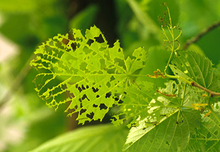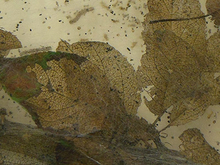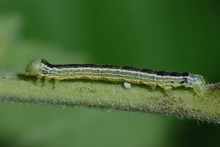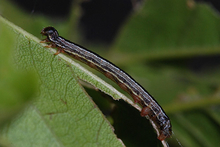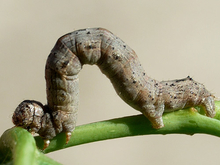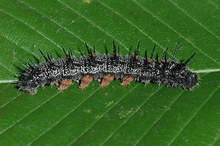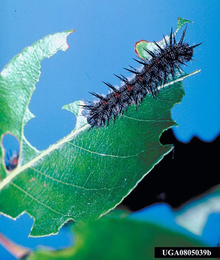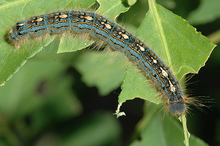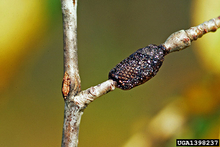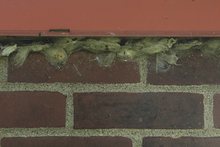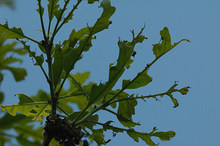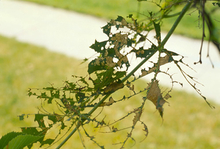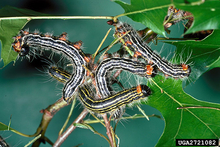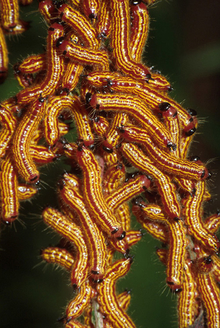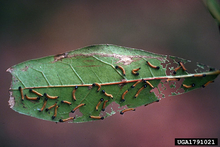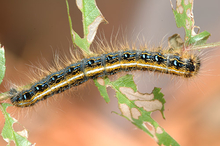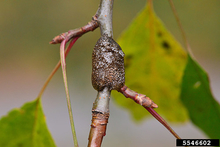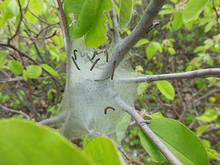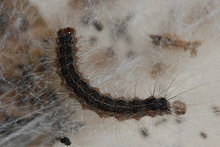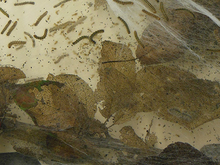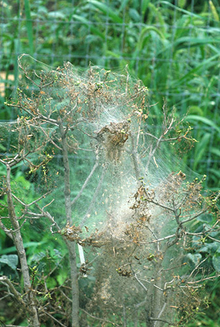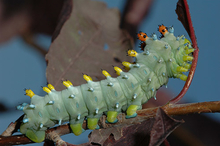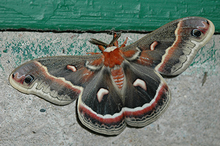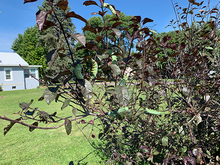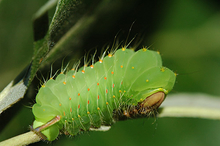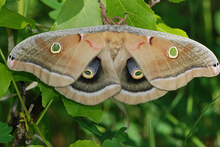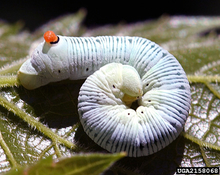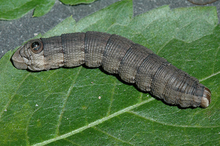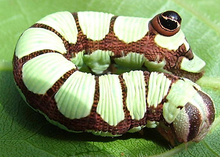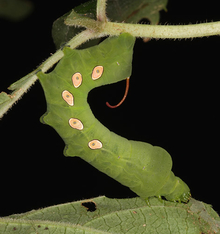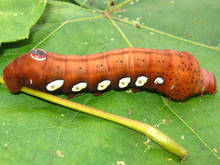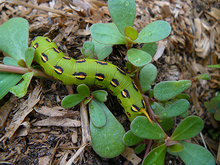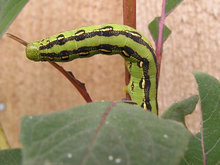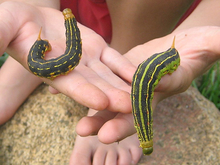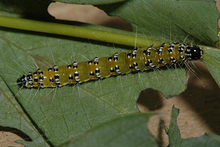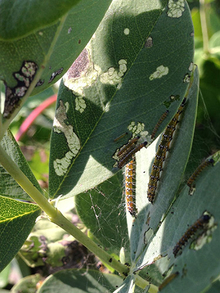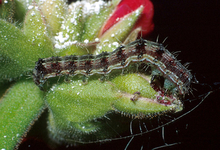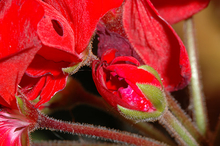Quick Facts
- Caterpillars feed on a wide variety of trees, shrubs, perennials and annuals.
- In most cases, ornamental plants tolerate caterpillar feeding and treatment is unnecessary for plant health.
- If management is necessary, there are several effective non-chemical and low-risk insecticide options.
How to identify caterpillars
Caterpillars turn into moths and butterflies. They can be very different in appearance.
- Fully grown larvae range in size from ½ to 4 inches (13-102mm ) in length.
- Larvae range in color from pink, brown, green and blue to black.
- Many have spots or stripes.
- Some caterpillars are smooth with few hairs while others are hairy and others have spines on their bodies.
Don’t confuse caterpillars with sawflies as they can look similar. The best way to tell the difference between them is to count the number of prolegs.
Prolegs are fleshy false “legs” that are present in both caterpillars and sawflies. Prolegs disappear when the larvae turn into adults.
- Moth and butterfly caterpillars have two or five (rarely three) pairs of prolegs.
- Sawflies have six to ten pairs of prolegs.
Distinguishing between these two groups of insects is important because management differs depending on which is present.
Biology of caterpillars
- Most moth and butterflies species spend the winter either as eggs or as pupae (a few species survive as adults).
- Many are active in the spring.
The time when this first occurs depends on how far north they are in Minnesota and whether we are experiencing a normal spring or an early or late one.
- Some caterpillars are not active until summer and can feed into the fall.
- Most caterpillars feed individually on leaves, although some feed in non-social groups.
- Collectively, caterpillars eat many different deciduous trees, shrubs and herbaceous plants.
- A few caterpillars in Minnesota feed on evergreen trees or shrubs.
Injury caused by caterpillars
Healthy, well-established ornamental plants can usually tolerate caterpillar feeding.
- Most caterpillar feeding only affects the plant's appearance.
- There are a few exceptions, such as spruce budworm defoliation on spruce and balsam fir.
- Young and unhealthy, stressed plants are less able to tolerate feeding.
- Severe feeding (e.g. for one to three consecutive years) may slow down plant growth, but plants usually are not killed.
Caterpillars can cause different patterns of damage to leaves. Sometimes different stages of the same caterpillar can create different types of damage.
- General feeding: eating entire sections, even entire leaves.
- Skeletonizing: feeding between the main veins of leaves.
- Windowpane feeding: feeding on one layer of leaf tissue between the veins. The damage is translucent (semitransparent) before eventually turning brown.
How to protect plants from caterpillars
Caterpillar feeding, as well as the presence of any webs, is usually just a cosmetic problem, only affecting plant appearance.
- Keep plants healthy, a healthy plant can more easily tolerate caterpillar feeding.
- Select plants that are hardy for your area and plant them in sites that encourage growth.
- Maintain plant health through proper cultural care, including watering and fertilizing. For information on tree and shrub selection and proper care, see Trees and Shrubs.
How much damage have the caterpillars caused?
- Ideally, caterpillars are best treated when damage is minor and before feeding becomes extensive.
- Once defoliation is severe, treating plants does not help protect them.
How large are the caterpillars?
- Treatment is most effective when caterpillars are small, no larger than half their full-grown size.
- Small caterpillars are easier to kill.
- Treating large caterpillars does not prevent feeding damage.
Management options
There are several situations where the best management is to take no action.
- The defoliation is minor and only small numbers of caterpillars are present.
- The caterpillars were noticed too late and are fully grown or nearly so and are finishing their feeding.
- The caterpillars are found on large, healthy trees, where feeding has no impact on plant growth.
Physically remove caterpillars that are on plants, shrubs and small trees, especially when only small numbers are present.
For forest tent caterpillars and eastern tent caterpillars, remove and destroy egg masses from branches of small trees before eggs hatch in the spring.
Remove eastern tent caterpillars by removing their webbing.
- Wait until the caterpillars have returned to their webbing at the end of the day or when it is raining.
- Pull out the webbing along with the caterpillars.
- Bury or bag them to properly dispose of them (burn them only where it is permitted).
Removing the webbing of fall webworms is more difficult and less effective.
Bacillius thuringiensis var. kurstaki (Bt) is a bacterium that occurs naturally in the soil. Caterpillars must eat the product for it to be effective. Get good coverage on the leaves when spraying. It is specific to caterpillars and does not affect other insects including bees. It works best on very young caterpillars.
Spinosad is derived from a naturally occurring soil-dwelling microorganism. It affects the nervous system and works well on chewing insects like caterpillars. It kills caterpillars when they ingest the product, although there is some effectiveness through contact. It is effective for about one to two weeks. It is toxic to bees when wet but much less active once it has dried.
Insecticidal soap is most effective against small caterpillars. This product must directly contact them to be effective. There is no residual activity so treatment may need to be repeated. Insecticidal soap has little or no activity against beneficial insects.
CAUTION: Mention of a pesticide or use of a pesticide label is for educational purposes only. Always follow the pesticide label directions attached to the pesticide container you are using. Be sure that the area you wish to treat is listed on the label of the pesticide you intend to use. Remember, the label is the law.
Conventional, or broad-spectrum pesticides, are longer lasting but they can kill beneficial insects. Common examples of broad-spectrum pesticides include permethrin, beta-cyfluthrin, bifenthrin, and lambda-cyhalothrin and other pyrethroids. One application is usually sufficient.
CAUTION: Mention of a pesticide or use of a pesticide label is for educational purposes only. Always follow the pesticide label directions attached to the pesticide container you are using. Remember, the label is the law.
Non-web building caterpillars on trees and shrubs
Spring cankerworms (Paleacrita vernata) and fall cankerworms (Alsophila pometaria)
Appearance:
- Smooth bodies with few hairs
- Spring cankerworms
- Yellow-green to brownish to blackish with a yellowish stripe along each side of the body
- Two pairs of prolegs
- Fall cankerworm
- Light green to dark green to black often with a whitish stripe along the side of the body
- Three pairs of prolegs
- 25 mm (1") long when fully grown
Hosts:
Many hardwood species including apple, ash, elm, hackberry, linden/basswood, maple, and oak trees as well as shrubs growing beneath heavily infested trees.
Life cycle:
- Eggs for both species hatch late April to mid-May.
- Feed four to five weeks and then drop to the ground to pupate.
- Fall cankerworm adults emerge during late fall after a hard freeze and lay eggs on small twigs where they remain until spring.
- Spring cankerworms pupate in late winter and emerge as adults in very early spring to lay eggs in bark cracks or under bark scales.
- There is one generation per year for each species.
Damage:
- Newly emerged cankerworms chew small BB-sized holes in leaves.
- Older larvae skeletonize leaves by chewing entire sections of leaves, except for the major veins and midrib.
- Feeding is usually minor, although sometimes severe, and even complete, defoliation can occur.
(Nymphalis antiopa)
Appearance:
- Black bodies speckled with many tiny white spots
- Larger red spots run down the center of the top of the back
- There is a series of short, stout black spines around each segment of the abdomen
- Prolegs are red
- 51 mm (2") long or little more when fully grown
Hosts:
Prefers elm and willow but can also feed on aspen, birch, cottonwood, hackberry and poplar.
Life cycle:
- Overwinter as adults (mourning cloak butterflies) and emerge in early spring
- Eggs are laid in a cluster encircling twigs in the spring.
- Caterpillars are active from late April to early June and pupate in June or July.
- Adults emerge in mid-summer and are active until fall when they look for protected sites (e.g. wood piles, loose tree bark) in which to overwinter.
- There is one generation per year.
Damage:
Caterpillars feed in groups at first, eating entire leaves with branches defoliated one at a time. Damage is normally not severe.
(Malacosoma disstria)
Appearance:
- Mostly blue and black bodies with a row of white, footprint-shaped markings on their backs.
- Fine hairs are present along the sides of its body.
- 51 mm (2") long when fully grown.
Hosts:
They commonly feed on aspen, birch, oak, linden, and ash and many other hardwood trees and shrubs. They can also eat herbaceous plants, like flowers and vegetables when caterpillars move off trees.
Life cycle:
- Overwinter as eggs in masses that encircle small twigs.
- Eggs hatch early to mid-May; caterpillars feed for five to six weeks.
- By the end of June, caterpillars pupate on tree trunks or other objects, including nearby buildings.
- Adult moths emerge from cocoons about two weeks later.
- There is one generation per year
- Populations go through cycles; numbers are low for eight to thirteen years, then high, outbreak numbers for three to five years
Damage:
They devour and defoliate entire sections of leaves. During severe infestations, they commonly defoliate entire trees. They can be a nuisance when large numbers of caterpillars move off trees and crawl on homes and other property and make cocoons.
(Orgyia leucostigma)
Appearance:
- Hairy yellowish bodies with bright red heads.
- Two long black bundles of hair that point forward near the head and a blackish tuft of long hairs at the tip of the abdomen.
- Four cream-colored squarish tufts on top of their bodies.
- 32 mm (1 ¼") long when fully grown.
Hosts:
Many hardwood trees and shrubs including apple, birch, dogwood, elm, linden/basswood and poplar. Evergreens, including fir, hemlock, larch and spruce, are occasionally attacked.
Life cycle:
- Overwinter as eggs.
- Caterpillars hatch in the spring between mid to late May and feed for about five to six weeks.
- A second generation is produced with caterpillars hatching in August and feeding into September.
Damage:
Young larvae feed on one layer of leaf tissue between the veins, giving leaves a lacey or transparent look (i.e. window feeding damage). Older caterpillars consume entire leaves, except for the petioles, midveins and other large veins.
(Datana ministra)
Appearance:
- Black head with orange yellow rectangular spot behind it.
- Alternating black and yellow or white striped body covered with fine white hairs.
- The larvae have two color phases:
- Black with orange-yellow stripes
- Orange-yellow with red-orange stripes.
- When threatened, yellownecked caterpillars lift their heads and tails into a “U” shape.
- 51 mm (2") long when fully grown.
Hosts:
Many hardwood trees and shrubs including apple, birch, blueberry, elm, honeylocust, maple, mountain ash, oak, sumac and walnut.
Life cycle:
- Overwinter as pupae 51 - 102 mm (2 - 4") in soil.
- Adult moths emerge in June and July and lay clusters of 100 or more eggs.
- Eggs hatch in July or August and begin feeding in nonsocial groups for about four to six weeks from July to September.
- There is one generation per year.
Damage:
Young caterpillars skeletonize leaves, feeding between the veins. Older caterpillars consume entire leaves except for the petioles. When they finish defoliating one branch, they move to an adjacent branch to continue to feed.
Web building caterpillars on trees and shrubs
(Malacosoma americanum)
Appearance:
- Blue and black bodies with a white stripe running down the top of their body and thin wavy orange markings along the sides.
- Tufts of white hairs along the side.
- 51 mm (2") long when fully grown.
Hosts:
Primarily on apple, cherry, chokecherry, crabapple, hawthorn and plum.
Life cycle:
- Overwinter as eggs in clusters encircling small twigs and branches.
- Larvae hatch in late April to mid-May and feed for four to six weeks
- These young caterpillars produce a silken webbing in branch forks
- As caterpillars grow larger, they enlarge the webbing
- Caterpillars feed on leaves outside their tents during the day and return at night or during rainy weather.
- Caterpillars form white cocoons on tree trunks and other objects in June.
- Adults emerge in July.
- There is one generation per year.
Damage:
Caterpillars eat individual leaves; branches and trees can potentially be completely defoliated. The webbing in forks of trees can be unsightly but does not damage plants.
(Hyphantria cunea)
Appearance:
- Highly variable in color from pale green or yellow to dark gray
- Head varies from red or black
- There are two rows of black spots on their back.
- Body covered with many long fine gray to white hairs.
- About 25mm (1") long when fully grown.
Hosts:
Many hardwood trees and shrubs including ash, apple, black walnut, birch, boxelder chokeberry, cottonwood, elm, oak, and willow.
Life cycle:
- Overwinter as pupae in cocoons under bark.
- Adults emerge late June or July; females lay eggs in clusters on the underside of leaves.
- Caterpillars hatch in July and feed in nonsocial groups.
- As they feed, they caterpillars create a web that covers the ends of the branches; as the caterpillars grow, they enlarge the webbing.
- Entire trees can be covered with webbing.
- Caterpillars spend most of their life inside the webbing.
- By fall, mature caterpillars leave the webbing to pupate.
- There is one generation per year.
Damage:
Young caterpillars windowpane feed the leaves, that is chew between the major veins; older caterpillars consume entire leaves. Fall webworm feeding is usually limited on mature trees. Heavy infestations of small trees or shrubs can cause complete defoliation. Although the webbing can be unsightly, it does not damage trees.
Large, showy caterpillars
(Hyalophora cecropia)
Appearance:
- Light green with a white dusty appearance.
- Double row of reddish-orange knobs (turbercles) behind the head.
- A series of smaller yellow and blue knobs (turbercles) on the abdomen.
- These knobs do not harm people.
- Up to 102 mm (4") long when fully grown.
Hosts:
Many different hardwood trees including birch, boxelder, cherry, elm, hawthorn, linden or basswood, maple, oak, poplar and willow.
Life history:
- Overwinter as cocoons, usually attached to branches or to trunks
- Emerge as adult moths the following spring
- Females lay eggs on twigs
- Caterpillars are active from summer to fall when they pupate.
- There is one generation per year.
Damage:
Sections of leaves and even entire leaves can be eaten. Fortunately, they rarely, if ever, are abundant enough to cause damage to trees.
(Antheraea polyphemus)
Appearance:
- Pale green and stout-bodied
- Sparse long, non-stinging hairs along the top and sides of the abdomen.
- About 89 mm (3 1/2") long when fully grown.
Hosts:
Many deciduous trees and shrubs including ash, birch, dogwood, grapes, maple, oak and willow.
Life history:
- Overwinter as cocoons on the ground.
- Emerge as adult moths the following spring.
- Caterpillars are active from summer into the fall, pupating in the fall.
- There is one generation per year.
Damage:
Caterpillars feed on sections and entire leaves but are rarely, if ever, abundant enough to cause damage to trees.
(Sphecodina abbottii)
Appearance:
- Caterpillars vary in color as they grow.
- First, they are green with a horn on the tip of their abdomens
- Then they are bluish green with light cross stripes and an orange knob (instead of a horn).
- As mature caterpillars, they are mottled brown or brown with ten green squarish patches along its back.
- Both forms have an eye-like knob at the end of the abdomen.
- Caterpillars are up to 76 mm (3") long when fully grown.
- Can make a noise when disturbed.
Hosts:
Vines in the grape family (Vitaceae) including grape, Virginia creeper, and woodbine.
Life history:
- Overwinter as pupae in shallow burrows in the soil
- Adults emerge in spring and are active May and June
- Females lay eggs on the underside of leaves.
- Caterpillars are active June and July
- Caterpillar pupate in the soil soon after they mature
- There is one generation per year.
Damage:
Caterpillars chew holes in leaves as they feed. Generally, little damage occurs, although it is possible for severe defoliation in localized sites.
(Eumorpha pandorus)
Appearance:
- Color variable: green to orange to pink to reddish-brown with whitish roundish spots along the body and black flecks around the head.
- Young caterpillars have a thin, curled tail on the end of the abdomen
- In older caterpillars, a “button” replaces the tail.
- Up to 89 mm (3 ½") long when fully grown.
Hosts:
Vines in the grape family, (Vitaceae) including grape, Virginia creeper, and woodbine.
Life history:
- Overwinter as pupae several inches deep in the soil.
- Adults emerge June and July and lay eggs
- Caterpillars hatch and are active July into September.
- There is one generation per year.
Damage:
Caterpillars chew holes in leaves as they feed. Generally, little damage occurs, although severe defoliation is possible in localized sites.
(Hyles lineata)
Appearance:
- Smooth with few hairs; color is widely variable.
- Greenish with orange, yellow, and black spots connected by a thin yellow line running down each side
- Some caterpillars are greenish with black stripes.
- Some are mostly black with some greenish-yellow on them.
- Some are nearly entirely black.
- A distinctive yellow to orange horn on the end of its body.
- This horn is sometimes tipped with black.
- Legs and prolegs are usually orange.
- About 76 mm (3") long when fully grown.
Hosts:
Feed on ash, evening primrose, grapes, lilac, privet, plants in the rose family (Rosaceae), several herbs and other woody plants.
Life history:
- Overwinter as pupae in the ground.
- Adult moths emerge in May and June and lay eggs on host plants.
- Larvae feed June and July and then pupates.
- Adult moths emerge starting in July and are active into September.
- Larvae feed August through September and into October.
- There are two generations per year.
Damage:
Feeding is often minor although at times it can be severe; plants typically survive defoliation.
Caterpillars on perennials and annuals
(Papilio polyxenes)
Appearance:
- Young caterpillars are generally black with white and yellow markings.
- Mature caterpillars are yellow-green with black bands dotted with orange spots.
- Up to 51 mm (2") long when fully grown.
Hosts:
Primarily plants in the carrot family including carrot, celery, dill, parsley, fennel, Queen Anne’s lace and other herbs.
Life History:
- Overwinter as chrysalises.
- Adult butterflies hatch May and June and lays eggs on host plants.
- Newly hatched caterpillars feed for three to four weeks and then pupate.
- Adults emerge, starting in July, and lay eggs that start to hatch in early August.
- Caterpillars feed through September.
- There are two generations per year.
Damage:
Feeding is typically minor; severe defoliation is uncommon.
(Uresiphita reversalis)
Appearance:
- Black head with white markings and a slender mustard-colored body.
- Black and white raised spots (tubercles) running down its body with white hairs coming out of them.
- About 25 mm (1") long when fully grown.
Hosts:
They feed primarily on false indigo, Baptisia spp. They can also feed on lupine and honeysuckle.
Life history:
- This moth does not appear to survive winters in Minnesota, so any individuals are migrants from regions farther south.
- Adults lay eggs starting in July.
- Caterpillars feed July to September
- Young caterpillars web leaves together and feed inside them.
- Older caterpillars move outside the webbing and continue to feed.
- They try to overwinter as pupae.
- There is one generation per year in Minnesota.
Damage:
Young caterpillars windowpane feed the leaves, that is chew between the major veins; older caterpillars consume entire leaves. Feeding can potentially be severe, although plants typically survive the defoliation.
(Heliothis virescens)
Appearance:
- White stripes running lengthwise along the abdomen.
- There are numerous erect hairs on its body.
- They are commonly brown but can also be red, purple or green depending on what they are eating.
- Up to 44 mm (1 3/4") long when fully grown.
Hosts:
They commonly feed on petunias, geraniums and nicotiana. They can sometimes damage roses and other plants.
Life cycle:
- Tobacco budworms do not survive winters in Minnesota.
- They arrive in Minnesota during late summer by riding on air currents from the south.
- They may be seen one year but are not automatically present the next year.
Damage:
They damage flowers by chewing holes into the buds. Flowers can still emerge from these damaged buds but flowers have large holes in the petals. Tobacco budworms may also eat the flower blossoms, giving them a ragged appearance.
Learning about caterpillars
There are many species of caterpillars not included with this information. If you are interested to identify and learn about other species or would like to look up more information about the species discussed here, the following are a few of the many resources available.
- Caterpillars of eastern North America: A guide to identification and natural history David L. Wagner.
- Moths and caterpillars of the North Woods Jim Sogaard
- BugGuide
- Butterflies and Moths of North America
- North American Moth Photographers Group
Reviewed in 2020




